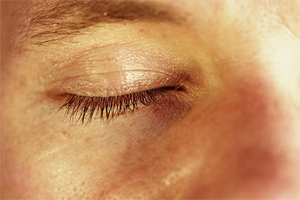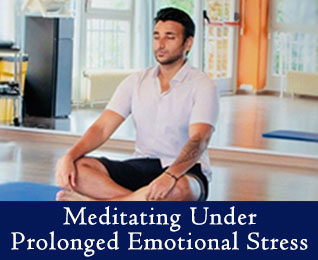Here is an interesting question from a reader, and my answer:
Question:
My question concerns the pros and cons of having one’s eyes open while doing EFT. This has come up recently with two different clients who seem to be almost unable to keep their eyes open when tapping. Their stress subsides, they look and act MUCH calmer, and report that they feel much more relaxed and relieved after the tapping but appear to almost be in a trance. Somewhere a bell is ringing that I have read something about having clients keep their eyes open.
When I think of my own personal use of EFT, in the past year and a half I’ve had my eyes open sometimes and sometimes closed — — both working very well… I would appreciate learning any ideas you have on this subject.
Pat’s Answer:
To answer your question with regard to whether or not your eyes should be open during EFT, I’ve never heard of a restriction on this and I checked with EFT’s Founder Gary Craig and he hasn’t either — he certainly never said people must keep their eyes open and his reaction to the question is roughly the same as mine. While most people seem automatically to keep their eyes open most of the time during EFT, we can’t see any objection to people having their eyes closed during it if that is what they prefer.
Actually, it’s even possible that this might be an advantage. Gary suggests that having your eyes closed might improve the process because then you wouldn’t be distracted by sights and sounds around you and might experience EFT in more depth. We both felt that this possibility is worth exploring, so if you want to compare eyes-closed with eyes-open EFT, please let me know your reactions by commenting below.
What we may be talking about is the great individuality of people with regard to what works and what doesn’t work with EFT (and most other things in life for that matter!). Personal preference and circumstances obviously play a large part here. I sometimes use EFT, for example, to get to sleep at night when I am wound up and sleep is not coming easily. For obvious reasons, at that time I keep my eyes closed because it seems to facilitate the sleep process. I tend to do EFT mentally at that point too rather than actively tap with my fingers because I find the latter tends to make me more wakeful. “Even though I’m wide awake, I choose to feel pleasantly drowsy” seems to work beautifully for me with EYES CLOSED.
This doesn’t mean that closing my eyes when I do EFT during the day will necessarily produce sleep. However, my personal experience has been that it does create a somewhat different mood than EFT with eyes open. Since external stimuli are shut out, my focus on EFT becomes more personal and immediate for me. I find that intense concentration and a sense of turning inward are fostered by closing my eyes during the process and my mood becomes more meditative in nature. I will experiment with this more after having read your question.
Now to address your other concern. You say that the two clients who seem to be almost unable to keep their eyes open when doing EFT, typically experience what I think most of us would agree is a very good outcome. They feel “much more relaxed and relieved”. An old saying comes to my mind: “The proof of the pudding is in the eating,” meaning look at the results when you’re trying to judge a situation. My question to you is, if your clients are benefiting this much does it really matter whether or not they are in trance? It seems to me to be somewhat irrelevant although I have a bit more say about this.
The question this raises is – “Is a trance state good or bad?” It’s been my experience that in most cases the light trance induced by the EFT (forgive me for making such a statement, I will explain why I say that in a moment) greatly facilitates positive suggestions made during this state and results in a strong carry-over of the benefits of EFT to everyday life.
Why then do so many people believe that a light trance is necessarily something negative and to be avoided? I think it’s because the word “trance” tends to bring a negative image to our minds. According to Webster’s dictionary, for example, it implies an inability to function or being in a state of daze or stupor. People frequently imagine the trance of deep hypnosis where the person has only limited contact with her surroundings and may be unable afterwards to recall what went on during the trance.
That’s a certain kinds of trance, to be sure, but in actual fact it’s neither the only one or the most prevalent. LIGHT trance states are very common everyday occurrences for all of us and do not ordinarily possess these alarming qualities. They simply involve a sharp narrowing of our attention, which becomes focused on only a few objects or events or thoughts. Because of this narrowing of attention, our generalized reality-orientation — that is, our awareness of our surroundings and of our usual ways of thinking and perceiving —begins to fade, creating a “trance” effect. Dr. Ronald Shor, a prominent specialist in hypnosis, described his own experience with such a spontaneous trance this way:
“I was reading a rather difficult scientific book which required complete absorption of thought to follow the argument. I had lost myself in it and was unaware of the passage of time or my surroundings. Then without warning, something was intruding upon me; a vague, nebulous feeling of change. It all took place in a split second and when it was over I discovered that my wife had entered the room and had addressed a remark to me. I was then able to call forth the remark itself which had somehow etched itself into my memory even-though at the time it was spoken I was unaware of it.” (R. E. Shor, 1969)
Obviously many everyday occurrences involve entering a state of light trance, although we may not call the state we experience by that name. We know, for example, how artists may be intensely absorbed in their work during its inspirational phase and become practically oblivious to their surroundings. The same absorption can occur when we are deeply involved in some majestic scene or in an engrossing game, or in viewing a work of art, listening to music, or making love… or, perhaps when doing EFT. Does this mean that we should consider these activities as being forms of “self-hypnosis”?
No, although unquestionably both EFT and self-hypnosis involve some degree of trance, there are some important differences between them as well as some similarities. One of the identifying characteristics of self-hypnosis, however, is increased receptiveness of subjects to self-administered suggestions about mental or physical behavior they want to bring about. The self-hypnotized person acts (or thinks) according to suggestions he gives himself when in trance — so does the person doing EFT.
The introduction of a positive affirmation into the EFT process is a major component of EFT. Gary Craig led workshop members in demos by “installing” positive affirmations and insights repeatedly, often using a different one at each tapping point. This is, in fact, one of Gary’s most impressive advanced EFT techniques.
There’s no doubt in my mind that positive suggestions and affirmations take effect more quickly and more profoundly during EFT than during ordinary “fully waking” life, and this strongly suggests that there is a hypnotic component to EFT, as there is to EMDR, NLP, meditation, and most other therapeutic interventions. If they are effective they usually involve a normal and reversible state of light trance.
There’s no need when using EFT for any “hypnotic induction” or for special props or for anything special to occur in order to create a state where positive suggestions can reach the very core of a person. Actually, this is quite a stunning achievement if you think about it!
I hope this answer helps,
Pat Carrington






